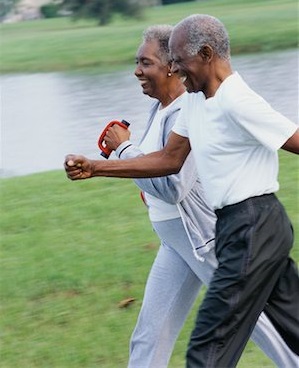By Oluwasola Samuel, Datelinehealth Africa Volunteer Freelance Writer, with editorial support from The DLHA Team
It's a known fact that when not properly managed, people with high blood pressure are at risk of stroke, heart attack, congestive heart failure, kidney damage, loss of vision, or memory loss.
As you may well know, central to the proper management of high blood pressure (hypertension are lifestyle changes and medication.
One of several lifestyle changes that helps in bringing high blood pressure under control, is exercise. Are you aware of this?
Well, in this article, we will discuss:
This is the measurement that shows the amount of force the heart uses to pump oxygen-rich blood throughout the arteries to the parts of the body that need it.
Blood pressure is measured using a sphygmomanometer, also known as a blood pressure gauge or blood pressure monitor. It could be high (hypertension), moderate, or low (hypotension).1 Much of this article will be focused on the use of exercise to help lower high blood pressure (hypertension).
So, let's delve into the topic properly.
Are you wondering what exercise can help you control your blood pressure? Here are some that can be effective:
 This is a moderate-intensity form of walking exercise that involves you walking at a not-too-slow and not-too-fast pace. This type of walking falls in between strolling, jogging, and running, and is generally done at a speed of 3.5 to 4.5 miles per hour (5.6 to 6.4 kilometers per hour).
This is a moderate-intensity form of walking exercise that involves you walking at a not-too-slow and not-too-fast pace. This type of walking falls in between strolling, jogging, and running, and is generally done at a speed of 3.5 to 4.5 miles per hour (5.6 to 6.4 kilometers per hour).
Exercise such as brisk walking is a great way to stay active and keep your body in shape. It poses a lower risk of injury compared to other forms of exercise and has many benefits such as lowering body weight, improving coordination, endurance, and cardiovascular health, and reducing the risk of diabetes and stroke.
According to a study conducted on over 500,000 walkers in the UK, the researcher suggested a link between walking speed and an increased risk of cardiovascular disease.2 The researcher noted, however, that additional research is needed to confirm these findings.
 Engaging in regular physical exercise helps maintain a healthy body and mind. Being active can reduce the chance of heart-related illnesses. Cycling is a good choice of aerobic activity that can be classified as a moderate or high-intensity workout depending on the pressure exerted while cycling.
Engaging in regular physical exercise helps maintain a healthy body and mind. Being active can reduce the chance of heart-related illnesses. Cycling is a good choice of aerobic activity that can be classified as a moderate or high-intensity workout depending on the pressure exerted while cycling.
When you cycle, your heart and breathing rate increase, which leads to a stronger cardiovascular system and makes it more efficient over time. This way, your heart pumps blood more efficiently to areas of your body, which helps reduce the pressure on your arteries and improve circulation.
 Exercise is an important part of maintaining a healthy lifestyle. Swimming is a great form of low-impact exercise that relieves stiffness in your joints and blood vessels, which can reduce the pressure on your artery walls. A lack of regular physical activity can lead to cardiovascular diseases, which can be fatal if left unchecked. No matter your age, staying active is essential for both your physical and mental health.
Exercise is an important part of maintaining a healthy lifestyle. Swimming is a great form of low-impact exercise that relieves stiffness in your joints and blood vessels, which can reduce the pressure on your artery walls. A lack of regular physical activity can lead to cardiovascular diseases, which can be fatal if left unchecked. No matter your age, staying active is essential for both your physical and mental health.
Swimming is an enjoyable form of exercise that is both easy and enjoyable to do. Being in the pool can relax your muscles and loosen up your joints, giving you a feeling of freedom in the water. While swimming, your blood pressure can rise due to the movement in the water, helping to improve your heart health and circulation.3
According to a study carried out on stage 1 or 2 hypertension patients during a 10-week water aerobics exercise, it was found that continuous swimming aerobics reduced the pressure on the patient's arteries.
Swimming is an ideal exercise recommended for individuals who are obese, have high blood pressure, or have physical or mobility challenges.
This is a type of strength training exercise that elevates your blood pressure temporarily but strengthens and improves your overall health. Some medical experts argue that endurance training has a much better effect on blood pressure control, but the truth is that consistent exercise generally has a positive effect on overall health and fitness.
Click on image to enlarge
Combining weight training with aerobic exercise can help reduce risk factors like high cholesterol, diabetes, and obesity, leading to improved heart health. When deciding what type of exercise to do at home or the gym, consider incorporating weight training with the help of a gym instructor.

Jogging or running at a moderate pace can help reduce your blood pressure over time. Start slowly and gradually increase your intensity as you become more comfortable. When you jog, your heart rate will increase and more blood will be circulated throughout your body.
Regular jogging can assist with maintaining a healthy weight, decreasing cholesterol levels, and increasing the flexibility of your blood vessels. This can ultimately help to manage your blood pressure.
Don't be surprised to see dancing make the list; dancing can be both a moderate- and high-intensity form of exercise. When you dance, your body's movement will cause your heart rate and blood pressure to increase based on the intensity of your dancing. This kind of movement can help to control your blood pressure and heart rate.
The physical activity of dancing also helps to expand and contract the blood vessels, increasing the heart rate and decreasing the overall blood pressure. Also, dancing can help reduce stress and increase endorphins, which can help to reduce high blood pressure.
7. Others
Note that in addition to the exercises mentioned above, other exercises that can help you lower your blood pressure include:
According to a recommendation by the American Heart Association and American College of Cardiology, if you have high blood pressure, you should exercise at a low intensity and then gradually raise it as desired. You must carry out this activity, which must include resistance training, 3–4 days a week for at least 12 weeks, with each part lasting at least 30 minutes.
When you exercise, it is normal for your heart rate to increase and your systolic blood pressure to rise from 120 mm Hg to 130 mm Hg or higher.
People with high blood pressure should not participate in activities or exercises that involve sudden bursts or intense movements, as this can lead to aortic rupture, heart attack, or stroke.
Examples of some exercises to avoid by people known to have serious or poorly managed high blood pressure are weight lifting, skydiving, long or short sprints, and scuba diving.
Any temporary increase in blood pressure caused by exercise should reduce after a few hours following exercising.
Exercise alone may not significantly lower your high blood pressure.
However, when consistent exercise is combined with medication and other lifestyle changes, it may take up to 1-3 months to see significant lowering of existing high blood pressure.
Yes, you can exercise, but before you engage in any physical activity, ensure to meet with your medical practitioner to evaluate your current condition and provide advice on what kind of exercise is safe for you to do based on your blood pressure level.
Normal blood pressure should be less than 120 mm Hg (systolic) and less than 80 mm Hg (diastolic).
Kindly check the table below to have a clearer understanding of what's normal blood pressure and what's not.
|
Blood Pressure Category |
SYSTOLIC mm Hg (Upper number) |
DIASTOLIC mm Hg (Lower number) |
|
|
Normal |
Less than 120 |
And |
Less than 80 |
|
Elevated |
120 — 129 |
And |
Less than 80 |
|
High Blood Pressure (Hypertension stage 1) |
130 — 139 |
Or |
80 — 89 |
|
High Blood Pressure (Hypertension stage 2) |
140 or Higher |
Or |
90 or Higher |
|
Hypertensive Crises (Consult your doctor immediately) |
Higher than 180 |
And/Or |
Higher than 120 |
Table: Details ranges of normal and abnormal blood pressure
You should notify your doctor if you have elevated blood pressure. That is if it rises above 120–129 mm Hg (systolic) and less than 80 mm Hg (diastolic).
This is to check your blood pressure and ensure you make the necessary changes to nip it in the bud before it becomes life-threatening.
Exercise is beneficial in helping to lower blood pressure levels. While exercising may cause a temporary increase in blood pressure due to physical exertion, it will eventually return to normal levels after a brief period. People who are fearful of working out because of potential rises in their blood pressure should be reassured that regular exercise can help to keep it in check.
It is essential to speak with your general practitioner before engaging in any physical activity, especially those that involve quick or abrupt movements, as they can be potentially dangerous.
1. Correct way to take your blood pressure at home. Retrieved May 19, 2023.
2. Your guide to physical activity and your heart | NHIBI, NIH. 2006. Retrieved May 19, 2023.
3. Farahani AV, Mansournia MA, Asheri H, Fotouhi A, Yunesian M, Jamali M, et al. The effects of a 10-week water aerobic exercise on the resting blood pressure in patients with essential hypertension. Asian J Sports Med. 2010 Sep;1(3):159-67. doi: 10.5812/asjsm.34854.
Does exercise promote general health?
The role of diet in the control of hypertension: What Africans should know
Published: April 26, 2023
© 2023. Datelinehealth Africa Inc. All rights reserved.
Permission is given to copy, use and share content without alteration or modification and subject to attribution as to source.
DATELINEHEALTH AFRICA INC., is a digital publisher for informational and educational purposes and does not offer personal medical care and advice. If you have a medical problem needing routine or emergency attention, call your doctor or local emergency services immediately, or visit the nearest emergency room or the nearest hospital. You should consult your professional healthcare provider before starting any nutrition, diet, exercise, fitness, medical or wellness program mentioned or referenced in the DatelinehealthAfrica website. Click here for more disclaimer notice.